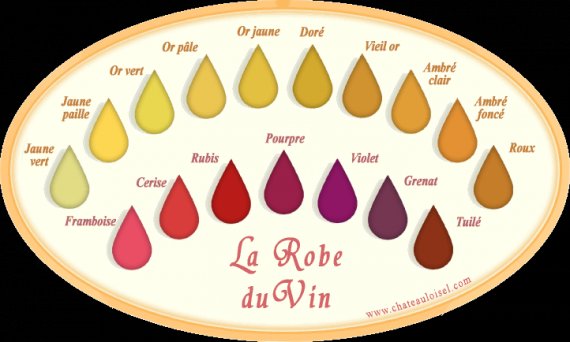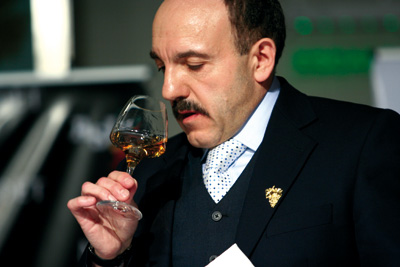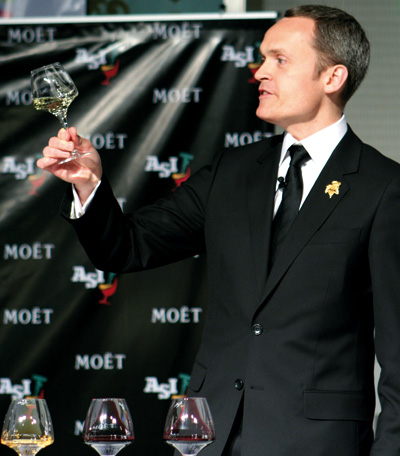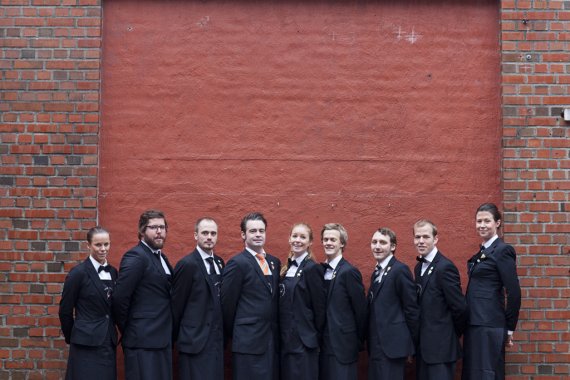-
My tasting
Yesterday I was for the first time in a contest of sommelier in oslo. i m very much appreciate the enthusiasm of sommeliers. Congratulations to these young people.I begin to read and understand Norwegian. What surprise when I read descriptions of wines, or when I listen to the young sommeliers. Everyone forget the two major, the mid-palate and retro olfaction. But nobody forgets the nose. Here's my opinion on the analysis of wine1/the first phase
often we forget - the qualifier of nose : open, pure or discrete
- first and second nose.
A/the color
always look at it against a white background.
the colour is not important for me because colouring can be added to dupe us. What follows is not gospel, but will serve better understanding.
Whites
Pale yellow with green tints: a wine that is normally vigorous, vinified in a vat.
Intense yellow with green tints: normally a rounder wine than the previous one, vinified in a vat.Intense yellow with no green tint: a round wine, normally vinified in a vat. Gold: white wine with a few years of age.
Orangey: white wine without added sulphur or having a few decades of age
Amber: old sauternes or syrupy with little sulphur. Rosés
Reds
Grenadine: rosé for meals. Salmon pink: delicate rosé.
Red currant: primeur.
Light cherry: young red coming from high yields or varietals like pinot or gamay (little pigment or light skinned)
Intense cherry: young red having lower yields than the previous wine Ink: wine coming from low yields and coloured varietals (syrah, cabernet, cot)
Brick: wine with a few years of age or that has peaked
Red with orangey nuances around the meniscus: wine with a few ears of age Red with brown tints inside and orangey around the meniscus: wine that is at least twenty years old that is in good shapeIn conclusion, watch if: The color is intense, young or evolved

the nose
often we forget - the qualifier of nose : open, pure or discrete - first and second nose. Indeed, watching the legs of the wine, each young sommelier move wine. The best way for me, it is look the color, after the nose and you finish by the legs of wine. For this third phase, I do not see a need to talk about.
The descriptions of the nose
Open: the nose is expansive. We have several possibilities here. the wine is made with laboratory-selected yeasts, because it engenders an aromatic character. the wine is already a few years old and in full maturity. the grape variety is aromatic (example: muscat, gewurztra- miner).
Discreet: the nose expresses itself only slightly, with discreet aromas. Wines vinified with natural yeasts express themselves in this manner.
Closed: you cannot manage to pick up the aromas of the nose. Complex: the 1st nose is different from the second.
Aromatic: the nose is explosive; the aromas are liberated and fill your nostrils.
-
∙ the wine has been vinified with laboratory-selected yeasts.
-
∙ the grape variety is aromatic (ex: gewurztraminer, muscat).
-
∙ the wine is fully mature.
Pure, Clean: a nose without a surplus of sulphur.

2/The mouth
the mouth is divided into three parts:
- Attack
- The mid-palate
- The final
a/the attack
often forgotten by professionals, when it is unctuous, that is evidence of a good grape maturity
this is the first sensation on the tip of the tongue. Supple: classic wine
Unctuous: wine with good phenolic maturity. It is the perfect balance between the skins, the seeds and the flesh of the grape.
Ample: sensation of amplitude. It can be combined with unctuosity and is proof of great phenolic maturity, but also of a great terroir.
Most wines are produced from grapes that are harvested when under ripe.their attack is supple.they represent 80% of the wines in France. the unctuous attack surprises the general public, who often say to me: “your wines are too sweet”, whereas their degree (of sugar) is natural and without chaptalisation.
b/The middle of the wine - palate
this is the flesh of the wine and the grape. It is the most difficult to define. It starts after the attack and ends before the finish.
Ample: sensation of amplitude
Concentrated: tight middle with a lot of content
Short: remains only fleetingly on the palate
Diluted: lacking concentration, the middle is short. this is the result of a (too) high yield of grapes.
Elegant: sensation of finesse
Full-bodied, powerful: an imposing sensation of powerDelicate: voluptuous middle
Long: sensation of longevity in the mouth
Thin: lack of amplitude.
Beading: possessing a bit of gas on the mouthSemi-full-bodied: neither too powerful nor too light
Semi-long: middle neither too short nor too long
Syrupy (for syrupy wines): the middle is unctuous like syrup.
Sharp: middle lively, clean.

C/The finish
two parts determine the finish:
In the mouth, just after the middleAfter deglutition (swallowing), the aromas come back to the mouth: this is retro-olfaction or recurrence in the mouth.
Description of finish
For whites, the finish can be: ∙ short
∙ long
∙ vigorous ∙ round
∙ sharp
∙ semi-longComment: a wine made from organically grown grapes (ripe, non-chapta- lised) and vinified with natural yeasts, generally possesses residual sugar. The finish is round.
For reds, you will find tannins that can be:
-
∙ supple (Gamay)
-
∙ hard and forward, which can create an imbalance in the wine or not (languedoc-roussillon, south West, young bordeaux)
∙ hard but fine (Pinot-noir or older wines) that do not create and imbalance in the wine
∙ rustic
∙ fleshy (syrah)the finish for red wines can be: ∙ long
∙ short
∙ semi-long
∙ unbalancedretro-olfaction
retro-olfaction is increased ten-fold when the wine is produced or- ganically and vinified with natural yeasts. I have never found great retro-olfaction with wines vinified with laboratory-selected yeasts. It determines the two styles of wine: spiritual and buccal (read Petit Dico des Vins Naturels).
the possible aromas that you will find in the retro-olfaction of white wines:
∙ menthol
∙ spice
∙ mineralityDepending on the wines and the vintage, you may also find:
-
∙ candied fruit
-
∙ grilled aromas
-
∙ brioche notes
-
∙ etc.
the possible aromas to be found in the retro-olfaction of red wines:∙ menthol
∙ liquorice
∙ mineralityDepending on the wines and the vintage, you may also find:
-
∙ red fruit
-
∙ leather
-
∙ undergrowth
-
∙ green / red pepper
Mineral retro-olfaction is in my view the mark of terroir in a wine. I have only found this in wines produced organically*, certified or not, and vinified with natural yeasts.
tastings Descriptions of retro-olfaction
∙ short
∙ complex
∙ long
∙ semi-long ∙ standard*Comment:
∙ There are organic wine makers who vinify with laboratory-selected yeasts. ∙ Only organic and biodynamic agriculture forbid chemical herbicides.NB: The most important thing when tasting is not to confuse the different phases.
C/Conclusion
During a tasting, the different phases should be described. but the last phase concludes what you feel. example: “Conclusion: this voluptuous wine with a masculine character (green pepper aromas and forward tannins) is great value for money and andré bourguet’s best vintage.” extract from Vin de Campagne 2007 – www.vinpur.com – directory
The descriptions of the conclusion
Buccal: wine where all the aromas are in the mouth without recurrence in the mouth.
Unbalanced: one of the tasting phases is not in harmony. Generally it’s the finish.
Feminine: beautiful elegance, everything is soft. Delicate: easy to drink, like a delicacy. Glug-glug: easy to drink.
Voluptuous: full of fruit.Intorchable: French wine term that is used to describe alive but currently undrinkable wine.
Thin: lacks amplitude.
Masculine: powerful, virile and concentrated.
Out of sync: wine that is alive but that is not balanced or in harmony.
Powerful and full-bodied: a sensation of power.
Pure: wine that possesses a mouth and nose without the aromas of chemical products.
Distinguished: having breeding. often without added sulphur, this living wine can surprise more than just amateurs.
Spiritual: wine that possesses long mineral retro-olfaction that haunts the taste buds.
Standard: wine that remains within the norm without having a sparkling personality.
recapitulation (extract from the Petit Dico des Vins Naturels) My descriptions for different wines
Red wine with supple tannins: red wine whose tannins provide supple- ness in the finish. example: beaujolais.
Red wine with hard tannins: red wine whose tannins induce linge- ring bitterness in the mouth. Good phenolic maturity will refine these tannins and balance the wine. example: Cabernet-sauvignon, Côt.
Red wine with fine tannins: red wine whose tannins are hard but fine. example: Pinot-noir or red wines with a few years of age.
Dry white wine: white wine whose sugar and acidity are equal. In white wine, we can distinguish several parts:
Vigorous wine: leaves a sensation of acidity at the back of the mouth like that of lemon. example: Gros-Plant from around nantes.
Semi-full-bodied white wine: a wine that is neither too light nor too powerful with a direct finish. example: Crozes-hermitage from laurent Combier, Menetou-salon, and bordeaux entre-Deux-Mers.
Round and ample white wine: this wine is not vigorous but it is dry. Its finish is round and its middle imposing. example: the whites of burgun- dy like Meursault, Corton-Charlemagne, certain Mâcons and Pouilly-Fuissé.
Floral white wine: a dry wine but with an aromatic nose and a round finish. It can at times have a bit of residual sugar. example: Gewurztra- miner, Muscat and Pinot-Gris.
Silky dry: demi-sec wine with a residual sugar finish. example: certain Vouvrays and Montlouis, and a few wines from alsace.
Syrupy white wine: sweet white wine having a syrupy middle and a round finish full of fruit.
White wine moelleux: white wine that is less sweet than the syrupy but with good acidity.this is often associated with minerality.
Recapitulation of the aromas of terroir and natural vinification present in the wine
When I was a young sommelier, wine makers often spoke of terroir in the wine without describing it to me. Meeting Claude Courtois at the end of the 1990’s was crucial for me. since then, here are my views:
Minerality: you have the impression of sucking a rock. you often find it in retro-olfaction with menthol and liquorice for red wines, and men- thol and spices for the whites. Do not confuse it in the nose with sul-
phur.
Barnyard: “natural yeasts give off sulphur. Certain wine makers, like Julien Guillot (les vignes du Mayne), Claude Courtois (les Cailloux du Paradis), Michel augé (les Maisons brûlées), claim that it is a kind of self-protection for the wine. all one needs do to eliminate this odour is decant the wine. If it persists, it is brett yeasts and it is a flaw.” (extract from Guide des Vins Vivants by Jean-Charles botte, anagramme Publishing.)
Wine marc (must): the sign of a pure and clean vinification.
A salty or saline aspect: blend of sugar and acidity. It can be foundin the great natural white wines.

-
-
My tasting

- Organic farming
- Loire: the forgotten of Robert Parker
- The term organic wine in europe
- Buccal wine and spiritual wine
- Different styles of wines in the world
- Travel through the organic vineyards
- the rosé wine
- THE OENOLOGISTS / WINEMAKERS
- My tasting
- Old vintages: how to know if ...?
- Natural wine
- Local Grappe
- Glug Glug wine what is it ?????
- Edition
